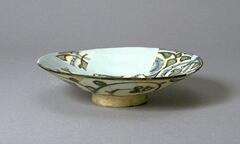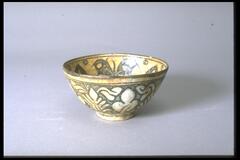Cabinet J: Shelf 2
Art of Islam
The millennium between the seventh and the seventeenth centuries marked the zenith of Islamic art and saw the creation of distinctive visual cultural forms as Islam was embraced by peoples of diverse ethno-linguistic backgrounds, ranging from Morocco and Spain on the Atlantic coast to Indonesia in Southeast Asia and from sub-Saharan Africa to Siberia.
In particular, during the rise of the Abbasid caliphate (749–1258) in a climate of political stability and prosperity, Islamic ceramics blossomed. Drawing on the influence of imported Chinese wares as well as local developments in metalware, craftsmen developed a wide range of techniques for making ceramics for both domestic use and architectural decoration. Many of the plates and vessels in the Museum’s collection are of a type called fritware. Invented in the twelfth century, fritware was an Islamic response to Chinese porcelain: by combining ground quartz with small amounts of white glaze, Middle Eastern potters were able to produce a thin-bodied, hard and durable white ware. Fritware provided an ideal surface for various painting techniques, including lustreware, underglaze painting, and overglaze enamels, all on display here (please see individual object descriptions). Also exhibited in this case is a selection of metalware. In the twelfth century, a new style of metalware emerged, where the surfaces of cast bronze objects were densely decorated in copper, gold, and silver inlays. Stunning examples of this can be seen in the two large candlesticks decorated with inscriptions and geometric patterns.
Created For
K-12 EducatorK-12 Student
Museum Visitor
UMMA Docent
UMMA Staff
University Faculty
University Student
Rate this Resource
AVG: 0 | Ratings: 0
& Author Notes
Creative Commons by-nc-saLast Updated
June 8, 2020 9:50 a.m.Report
Reporting Policy
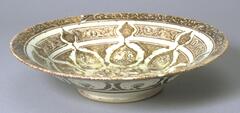
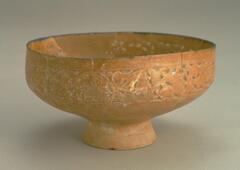
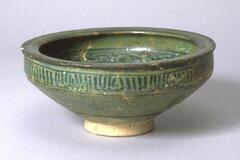
!["Object EFS-105 is a 14th century Mongolian-influenced Sultanabad work. The body of the object is a pinkish-tan while the outside is covered with painted blue tinge. The central motif is a spotted lion [leopard]. Stylized birds circle the inside of the object against a naturalistically conceived floral area. The object has been re-pieced extensively. <br /><br />
This object bears the characteristic hemispherical shape of Sultanabad work, and its rendering of the birds and floral motif indicate the Chinese influence of the 14th century. The animal and birds are outlined in black. It follows the general color scheme and motifs of the Sultanabad wares of the 14th century. <br /><br />
The object is 4 inches high and has a diameter of 8 inches. The lion [leopard] is rendered with the Iranian sensitivity and perceptiveness. This object was probably highlighted with white slip." "Object EFS-105 is a 14th century Mongolian-influenced Sultanabad work. The body of the object is a pinkish-tan while the outside is covered with painted blue tinge. The central motif is a spotted lion [leopard]. Stylized birds circle the inside of the object against a naturalistically conceived floral area. The object has been re-pieced extensively. <br /><br />
This object bears the characteristic hemispherical shape of Sultanabad work, and its rendering of the birds and floral motif indicate the Chinese influence of the 14th century. The animal and birds are outlined in black. It follows the general color scheme and motifs of the Sultanabad wares of the 14th century. <br /><br />
The object is 4 inches high and has a diameter of 8 inches. The lion [leopard] is rendered with the Iranian sensitivity and perceptiveness. This object was probably highlighted with white slip."](/media/W1siZiIsIjIwMjIvMDUvMjUvN3planB1NG5tbl9kZWZhdWx0LmpwZyJdLFsicCIsInRodW1iIiwiMjQweDIwMCJdXQ?sha=215dcc1d938a8d43)


